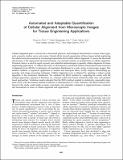| dc.contributor.author | Feng, Xu | |
| dc.contributor.author | Beyazoglu, Turker | |
| dc.contributor.author | Hefner, Evan | |
| dc.contributor.author | Gurkan, Umut Atakan | |
| dc.contributor.author | Demirci, Utkan | |
| dc.date.accessioned | 2011-09-27T20:13:39Z | |
| dc.date.available | 2011-09-27T20:13:39Z | |
| dc.date.issued | 2011-06 | |
| dc.identifier.issn | 1937-3392 | |
| dc.identifier.uri | http://hdl.handle.net/1721.1/66084 | |
| dc.description.abstract | Cellular alignment plays a critical role in functional, physical, and biological characteristics of many tissue types, such as muscle, tendon, nerve, and cornea. Current efforts toward regeneration of these tissues include replicating the cellular microenvironment by developing biomaterials that facilitate cellular alignment. To assess the functional effectiveness of the engineered microenvironments, one essential criterion is quantification of cellular alignment. Therefore, there is a need for rapid, accurate, and adaptable methodologies to quantify cellular alignment for tissue engineering applications. To address this need, we developed an automated method, binarization-based extraction of alignment score (BEAS), to determine cell orientation distribution in a wide variety of microscopic images. This method combines a sequenced application of median and band-pass filters, locally adaptive thresholding approaches and image processing techniques. Cellular alignment score is obtained by applying a robust scoring algorithm to the orientation distribution. We validated the BEAS method by comparing the results with the existing approaches reported in literature (i.e., manual, radial fast Fourier transform-radial sum, and gradient based approaches). Validation results indicated that the BEAS method resulted in statistically comparable alignment scores with the manual method (coefficient of determination R2=0.92 [R superscript 2 = 0.92]). Therefore, the BEAS method introduced in this study could enable accurate, convenient, and adaptable evaluation of engineered tissue constructs and biomaterials in terms of cellular alignment and organization. | en_US |
| dc.description.sponsorship | National Institutes of Health (U.S.) (NIH R21 (AI087107)) | en_US |
| dc.description.sponsorship | National Institutes of Health (U.S.) (NIH R01 (AI081534)) | en_US |
| dc.description.sponsorship | Wallace H. Coulter Foundation | en_US |
| dc.description.sponsorship | Center for Integration of Medicine and Innovative Technology | en_US |
| dc.description.sponsorship | United States. Army Medical Research and Materiel Command | en_US |
| dc.description.sponsorship | United States. Army. Telemedicine & Advanced Technology Research Center | en_US |
| dc.language.iso | en_US | |
| dc.publisher | Mary Ann Liebert | en_US |
| dc.relation.isversionof | http://dx.doi.org/10.1089/ten.tec.2011.0038 | en_US |
| dc.rights | Article is made available in accordance with the publisher's policy and may be subject to US copyright law. Please refer to the publisher's site for terms of use. | en_US |
| dc.source | Mary Ann Liebert | en_US |
| dc.title | Automated and Adaptable Quantification of Cellular Alignment from Microscopic Images for Tissue Engineering Applications | en_US |
| dc.type | Article | en_US |
| dc.identifier.citation | Xu, Feng et al. “Automated and Adaptable Quantification of Cellular Alignment from Microscopic Images for Tissue Engineering Applications.” Tissue Engineering Part C: Methods 17, no. 6 (2011): 641-649. Copyright © 2011, Mary Ann Liebert, Inc. | en_US |
| dc.contributor.department | Harvard University--MIT Division of Health Sciences and Technology | en_US |
| dc.contributor.approver | Demirci, Utkan | |
| dc.contributor.mitauthor | Demirci, Utkan | |
| dc.relation.journal | Tissue Engineering. Part C, Methods | en_US |
| dc.eprint.version | Final published version | en_US |
| dc.type.uri | http://purl.org/eprint/type/JournalArticle | en_US |
| eprint.status | http://purl.org/eprint/status/PeerReviewed | en_US |
| dspace.orderedauthors | Xu, Feng; Beyazoglu, Turker; Hefner, Evan; Gurkan, Umut Atakan; Demirci, Utkan | en |
| mit.license | PUBLISHER_POLICY | en_US |
| mit.metadata.status | Complete | |
